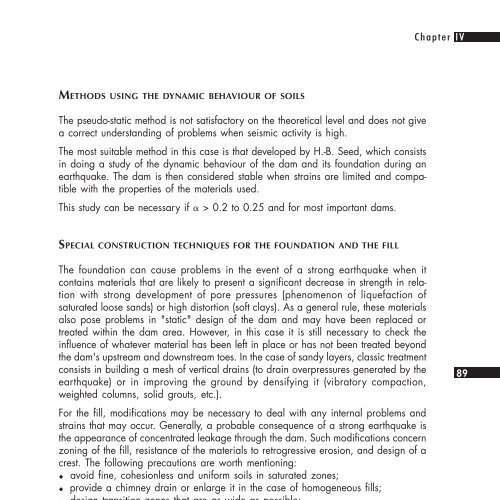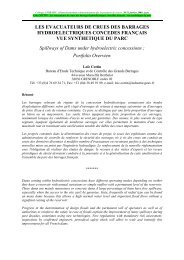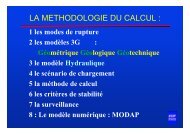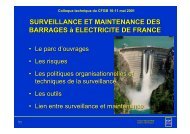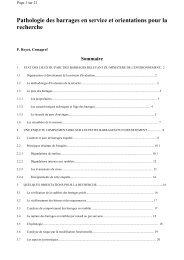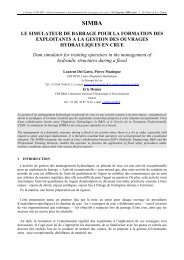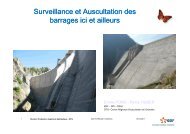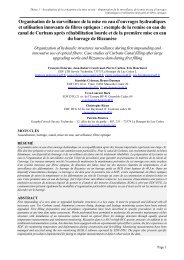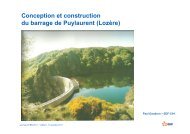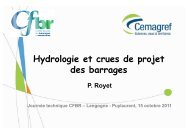SMALL DAMS
SMALL DAMS - Comité Français des Barrages et Réservoirs
SMALL DAMS - Comité Français des Barrages et Réservoirs
- No tags were found...
Create successful ePaper yourself
Turn your PDF publications into a flip-book with our unique Google optimized e-Paper software.
Chapter IV<br />
METHODS USING THE DYNAMIC BEHAVIOUR OF SOILS<br />
The pseudo-static method is not satisfactory on the theoretical level and does not give<br />
a correct understanding of problems when seismic activity is high.<br />
The most suitable method in this case is that developed by H.-B. Seed, which consists<br />
in doing a study of the dynamic behaviour of the dam and its foundation during an<br />
earthquake. The dam is then considered stable when strains are limited and compatible<br />
with the properties of the materials used.<br />
This study can be necessary if > 0.2 to 0.25 and for most important dams.<br />
SPECIAL CONSTRUCTION TECHNIQUES FOR THE FOUNDATION AND THE FILL<br />
The foundation can cause problems in the event of a strong earthquake when it<br />
contains materials that are likely to present a significant decrease in strength in relation<br />
with strong development of pore pressures (phenomenon of liquefaction of<br />
saturated loose sands) or high distortion (soft clays). As a general rule, these materials<br />
also pose problems in "static" design of the dam and may have been replaced or<br />
treated within the dam area. However, in this case it is still necessary to check the<br />
influence of whatever material has been left in place or has not been treated beyond<br />
the dam's upstream and downstream toes. In the case of sandy layers, classic treatment<br />
consists in building a mesh of vertical drains (to drain overpressures generated by the<br />
earthquake) or in improving the ground by densifying it (vibratory compaction,<br />
weighted columns, solid grouts, etc.).<br />
For the fill, modifications may be necessary to deal with any internal problems and<br />
strains that may occur. Generally, a probable consequence of a strong earthquake is<br />
the appearance of concentrated leakage through the dam. Such modifications concern<br />
zoning of the fill, resistance of the materials to retrogressive erosion, and design of a<br />
crest. The following precautions are worth mentioning:<br />
!" avoid fine, cohesionless and uniform soils in saturated zones;<br />
!"provide a chimney drain or enlarge it in the case of homogeneous fills;<br />
!" design transition zones that are as wide as possible;<br />
!" be especially prudent with the thickness of filters (place a layer of sand upstream<br />
from the core to plug any cracks that may be caused by an earthquake);<br />
!"build the dam or its core with materials offering good resistance to internal erosion<br />
(plastic clays, sandy gravel with clay fines of a very continuous grading).<br />
In addition, if the design earthquake is very strong, it may be wise to increase freeboard<br />
and crest width.<br />
89


